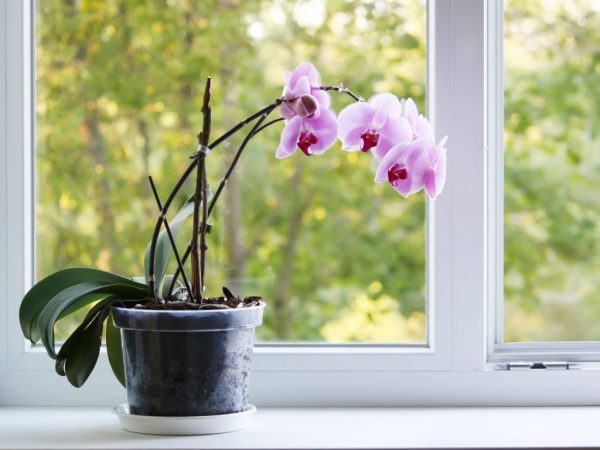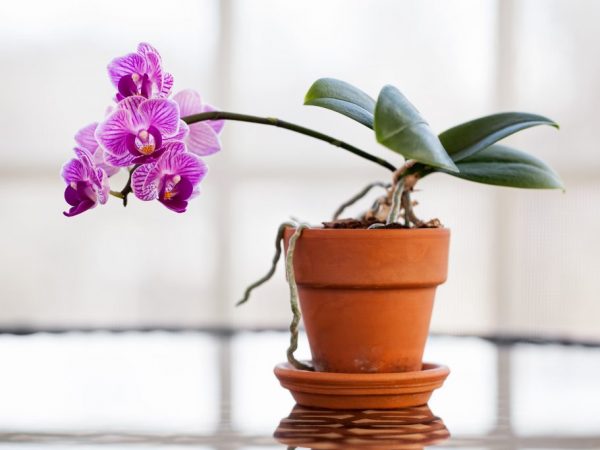Which is better to choose an orchid pot
Indoor orchids are delicate, moody plants that need to be cared for. First you need to choose an orchid pot.

Choosing an orchid pot
What to consider when choosing
Orchid is an epiphytic plant, it does not tolerate waterlogging of the soil. When choosing a landing container, this should be taken into account.
Orchid pots must have the following properties:
- active aeration of the root system and substrate;
- good moisture drainage;
- safe and easy extraction of the massive root system of the plant, which often goes beyond the container through the drainage holes;
- the ability to maintain the required temperature for the underground part of the flower.
Size Requirements
A pot of the appropriate size is selected for the orchid. Given the natural feature of the flower, it requires a slightly cramped flowerpot. In such conditions, the flower will bloom faster than in a voluminous flowerpot.
Parameters of a pot suitable for an orchid:
- diameter and height should correspond to the size of the neck;
- when choosing a container for a flower, take into account that its root system fits completely in it;
- when transplanting a flower, choose a flowerpot by volume 1 cm in diameter larger than the previous one.
Plastic
Almost all orchid varieties that you can find in a flower shop are sold in clear plastic containers. This orchid pot has several advantages:
- This is a budget option.
- Through plastic containers, you can see how the root system develops and how the substrate dries out, which eliminates the risk of overflow or drying out of the roots.
- Plastic pots for orchids are also good because the roots in them do not grow to the walls. The flower is easily removed when transplanting or dividing is necessary.
- The roots receive full daylight - this is one of the main conditions, because the root system of almost all types of orchids photosynthesizes.
Indoor plants grow, develop and bloom in such a pot for a long time, so do not rush to transplant them. If a different type of pot is needed for an orchid, select it by size: if there is a lot of space, the plant will spend all its energy filling the voids with roots.
Clay (ceramic)
Moisture and breathability are the main advantages of a clay pot for an orchid.
They are of two types:
- unglazed;
- glazed.
Ceramic unglazed flowerpots are used for planting plants that grow in their natural environment on the ground. This will be the most correct solution for growing such species. Growing in such a container, the roots of plants will breathe fully, and moisture will not stagnate.
The second option is less practical.Despite the elegant and attractive appearance, glazed ceramic flowerpots are treated with a special glaze, which prevents full air circulation and moisture permeability. Phalaenopsis orchid and other varieties of this exotic flower cannot be kept in such a pot for a long time. Otherwise, the plant will rot its roots and it will simply wither away.
Therefore, these flowerpots are not suitable for planting and growing these flowers. An exception is the glazed orchid pot, which has holes around its entire perimeter.
Dignity

Give preference to a ceramic container
If you do not know which type of container to choose - ceramic or plastic, do not hesitate, give preference to ceramics, and be sure to unglazed.
The plastic pot is unstable, so adult plants growing in it often fall off. The ceramic container provides good resistance to the flower.
Unlike a plastic flowerpot, the ceramic phalaenopsis orchid pot does not heat up in the sun, which means it prevents the risk of drying out and burning the roots.
disadvantages
This capacity also has some disadvantages:
- the roots of the plant quickly grow to the porous surface of the flowerpot, which often leads to injury during transplantation and reproduction;
- there is no way to monitor the condition of the roots, as well as to regulate their watering;
- salts penetrating into the walls of the flowerpot reduce its porosity, which negatively affects the state of the container and the root system.
In addition, such a flowerpot costs more than a plastic container.
From glass
Glass pots for orchids are used as decoration. Plants in plastic pots are placed in them. You can choose a glass orchid pot to your liking, the main thing is that it is 2-3 cm larger in diameter than the plastic container.
The main advantage of glass pots is the ability to monitor the state of the root system and regulate its watering. Water is poured from a watering can along the edge of a plastic container. The liquid flows down to the bottom and seeps through the holes, sinking to the very bottom. The plant saturates the required amount of moisture and distributes it evenly throughout the root system.
It should be understood that such a phalaenopsis orchid pot cannot be used for planting, since it is made with a cast bottom - without drainage holes.
Therefore, if you have a question, which is the best ceramic or glass pot for an orchid when planting or transplanting, give preference to the first option.
Today, glass pots of different colors, shapes and sizes are on sale. Most often they are used to grow Fijian orchids, phalaenopsis and other small plants.
Lechuza system with automatic watering
The modern market for such products offers another convenient and decorative option for planting any kind of orchid - lechuza.
The set of such planting pots includes several components:
- pots lechuza;
- separator;
- lechuza-pon soil;
- automatic irrigation system.
Operating principle
The separator, installed in the pots, is filled with a substrate, then the plant is planted. The first two weeks it needs to be watered superficially until it takes root. Then water is poured into the tank to the full mark. Further, the automatic irrigation system itself will take care of the plant's moisture needs.
According to the device, such containers are different: some provide for the bottom watering of the plant through the roots, others - seepage of moisture on the sides of the substrate. Some systems are additionally equipped with a special drainage, which ensures a uniform supply of water - expanded clay or polystyrene.
A double pot with water tanks, from which the plant absorbs moisture, provides effective and balanced soil moisture. In this case, the risk of drying out and waterlogging is excluded.Therefore, in your absence, the plant will not suffer from drought or overflow, and will retain its healthy and decorative appearance.
DIY containers

The pot can be made by yourself
Some flower growers manage to make flowerpots on their own from scrap materials. You can make such a container easily and without special knowledge from several materials.
From glass
Indoor orchids grow well in a glass container that you can make yourself. Such a container is perfect for growing a large wanda orchid, which has massive and long roots. The main condition is compliance with the watering rules, because there are no drainage holes in such a pot. The roots are placed just above the bottom of the vase.
Water is poured into a vase and the plant is left for 20-30 minutes to get drunk. We noticed how the root of the plant turned green - this is a sign that the plant has received the necessary dose of water and it is time to drain it.
Glass is not the most successful and suitable option, as it does not allow moisture and air to pass through. Therefore, many flower growers advise using other materials for the manufacture of planting containers.
From coconut
This is the perfect flower pot for growing small (miniature) species. Natural material will provide good air circulation and moisture permeability.
To make it yourself, you need one fruit. Cut it in half, drain the coconut milk, then use a sharp knife to scrape off the coconut and punch a few holes in the half of the coconut.
Dip the root system into a container, fill the voids with a mixture of sphagnum moss and fine pine bark. You can hang such a small flowerpot on your terrace, balcony or in any other convenient place. This coconut planter will be a great addition to your interior.
Lack of a pot - the roots will easily grow through the drainage holes, growing into a rough surface. This will create a problem in the process of transplanting and reproducing a flower, since it will be problematic to separate them from such a surface without damage.
Made of plastic
The most readily available material is plastic. For the manufacture of plastic containers, you can use any plastic container of any color. But it will be more correct if you choose a transparent container from under mayonnaise, sauce or yogurt.
Use a screwdriver, drill or any other tool to punch several holes in the bottom of the container and in the walls.
To improve air exchange in the middle of the bottom, insert a plastic champagne stopper. A flowerpot concave at the bottom will provide even distribution and aeration of the roots.
A transparent flowerpot can be placed in a large glass pot or equipped with a flat tray with pebbles or expanded clay. So you will provide flowers not only with full growth, but also development in a decorative container.
Baskets
The manufacture of such a container is carried out from different materials - stainless steel mesh, bamboo, plastic or wood.
To eliminate the risk of root accretion, the inner surface is made smooth. Roots are placed at the bottom, sprinkled with a substrate. The voids are covered with sphagnum moss.
When growing a plant in this way, do not forget about regular and frequent watering. Because in a trellis flowerpot, moisture will quickly evaporate.
If you don't have these materials on hand, you can use commercially available mesh baskets. Before planting the plants, make several holes in them to drain water and ensure good air permeability.
Conclusion
The containers for planting this plant are made of different materials, and it is not difficult to choose the right one. When choosing, pay attention to the peculiarities of growing and the external data of the Oridea. Its further health, development and flowering will depend on this.

